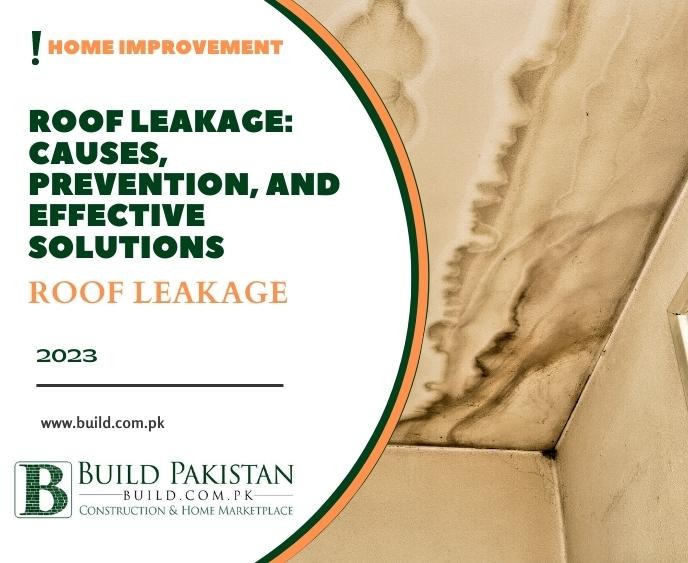Roof Leakage: Causes, Prevention, and Effective Solutions

Introduction:
A leaking roof can be a homeowner's nightmare,
causing damage to the house's interior, compromising structural integrity,
and leading to costly repairs. In this comprehensive blog post, we will explore
the causes of roof leakage, the importance of timely detection and repair,
prevention methods and effective solutions to address this common issue.
Understanding Roof Leakage:
Roof leakage refers to the
unwanted penetration of water into the interior spaces of a building through
the roof. It can occur due to various reasons, including poor construction,
aging materials, extreme weather conditions, or lack of regular maintenance.
Identifying and promptly addressing roof leakage is crucial to prevent further damage and ensure the roofing system's longevity.

Causes of Roof Leakage
Damaged or Missing Roofing Materials:
Cracked, curled, or missing shingles, tiles, or roofing sheets can
create openings for water to seep through. Damaged flashing around chimneys,
vents, and skylights can also contribute to roof leakage.
Improper Roof Installation:
Inadequate installation
techniques, such as improper sealing or incorrect placement of roofing
materials, can result in weak spots that are prone to leakage.
Poor Roof Ventilation:
Inadequate ventilation can lead to
moisture buildup in the atti, causing roof deterioration and potential leaks.
Clogged Gutters and Downspouts:
Accumulated debris,
leaves, or other obstructions in gutters and downspouts can prevent proper water
drainage, leading to overflow and water seeping under the roof.
Age and Wear:
Over time, roofs naturally deteriorate due
to exposure to the elements. Aging roofing materials may become brittle,
cracked, or weakened, making them more susceptible to leaks.
Extreme Weather Conditions:
Severe storms, heavy rainfall,
hail, or strong winds can damage the roof's surface, causing leaks.
Importance of Timely Detection and Repair
Structural Damage Prevention:
Prompt detection and repair of roof leaks help prevent
further damage to the roof structure, ceiling, walls, and other interior
components of the building.
Mold and Mildew Prevention:
Roof leakage can lead to
moisture buildup, creating an ideal environment for mold and mildew growth.
Timely repair prevents the formation of these harmful substances, which can
adversely affect indoor air quality and pose health risks.
Energy Efficiency:
Leaks can compromise the insulation and
thermal properties of the roof, leading to increased energy consumption and
higher utility bills. Fixing leaks helps restore the energy efficiency of the
building.

Prevention Methods
Regular Roof Inspections:
Conducting
regular inspections, at least once or twice a year, allows for early detection
of potential issues and timely repairs.
Proper Roof Maintenance:
Keeping the roof clean, removing
debris, and ensuring adequate ventilation can help prevent roof deterioration
and leaks.
Gutter and Downspout Maintenance:
Regularly clean and
maintain gutters and downspouts to ensure proper water drainage and prevent
overflow that could cause roof leakage.
Professional Roof Installation:
Hire experienced and
reputable roofing contractors for proper installation, ensuring that all
materials are installed correctly and securely.
Addressing Potential Weak Points:
Reinforce vulnerable
areas, such as flashing around vents, chimneys, and skylights, to prevent leaks.
Effective Solutions for Roof Leakage
Patching and Repair:
Small leaks can often be fixed by patching the damaged area with roofing cement
or using sealants designed for roof repair.
Roof Coating:
Applying a roof coating can provide an
additional layer of protection, sealing minor cracks and preventing water
penetration.
Roof Replacement:
In cases of extensive damage or an aging
roof, a complete roof replacement may be necessary to ensure long-term
leak-free protection.
Professional Roofing Services:
Engaging the services of
professional roofers ensures proper diagnosis, repair, and maintenance of roof
leakage issues, providing long-lasting solutions.
Conclusion:
Roof leakage is a common problem that requires
immediate attention to prevent further damage and costly repairs. Understanding
the causes, implementing preventive measures, and addressing leaks promptly
through proper repair and maintenance can safeguard the integrity of your roof,
enhance energy efficiency, and maintain a dry and protected interior
environment. Regular inspections, timely repairs, and professional assistance
are essential in preserving the longevity and functionality of your roof,
ensuring peace of mind for years to come









